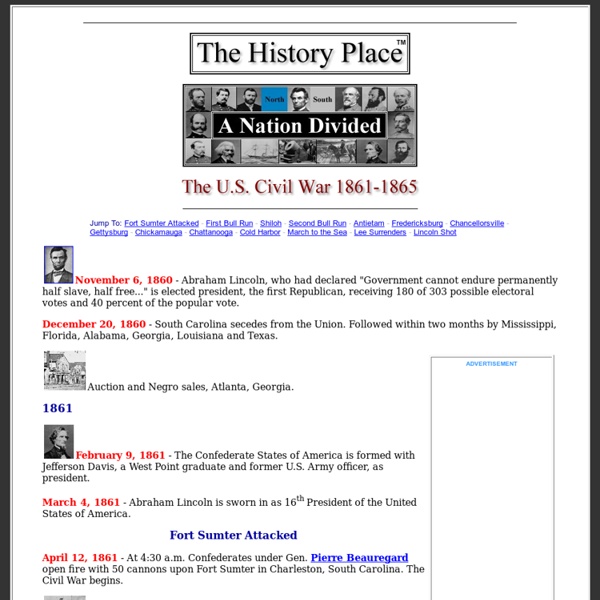Great American History - Free American History Educational Material
Civil War
John Quincy Adams
The first President who was the son of a President, John Quincy Adams in many respects paralleled the career as well as the temperament and viewpoints of his illustrious father. Born in Braintree, Massachusetts, in 1767, he watched the Battle of Bunker Hill from the top of Penn's Hill above the family farm. As secretary to his father in Europe, he became an accomplished linguist and assiduous diarist. After graduating from Harvard College, he became a lawyer. At age 26 he was appointed Minister to the Netherlands, then promoted to the Berlin Legation. In 1802 he was elected to the United States Senate. Serving under President Monroe, Adams was one of America's great Secretaries of State, arranging with England for the joint occupation of the Oregon country, obtaining from Spain the cession of the Floridas, and formulating with the President the Monroe Doctrine. Upon becoming President, Adams appointed Clay as Secretary of State.
Casualties Interactive Map
Kady Brownell | Civil War Women Blog
Female Soldier from Rhode Island Kady Southwell was born in 1842 in an army camp on the coast of Africa, where her French mother had traveled to watch her Scottish father on maneuvers. Accounts of her life have always been in dispute, but it is known that her mother died shortly after her birth. Kady did not appear in any census records until 1860. During that time, Kady met a millwright named Robert Brownell, who was six years older than Kady. In 1861, when the state of Rhode Island called for young men to enlist in the Union army for 90 days, Robert joined right away. Kady was determined not to be a water carrier or a laundress. Being the color bearer is a very dangerous job, because you cannot handle a gun and the huge heavy flag at the same time. In the middle of July 1861, the company marched into Virginia, to a place near Manassas, where the first battle of the Civil War took place. Kady ran on into the woods, where she found some of her comrades.
King Andrew the First
Title: King Andrew the First Date Created/Published: [New York? : s.n.], 1833. Medium: 1 print : lithograph on wove paper ; 31.7 x 21.4 cm. (image) Summary: A caricature of Andrew Jackson as a despotic monarch, probably issued during the Fall of 1833 in response to the President's September order to remove federal deposits from the Bank of the United States. The print is dated a year earlier by Weitenkampf and related to Jackson's controversial veto of Congress's bill to recharter the Bank in July 1832. View the MARC Record for this item. Rights assessment is your responsibility. The Library of Congress generally does not own rights to material in its collections and, therefore, cannot grant or deny permission to publish or otherwise distribute the material. Rights Advisory: No known restrictions on publication. If an image is displaying, you can download it yourself. Alternatively, you can purchase copies of various types through Library of Congress Duplication Services.
Women of the American Civil War Era
Kindle Title Carolina RainOpen the page of Carolina Rain and step on the streets of an era gone by. Carolina Rain is not just a read, but an experience. You will smell the magnolia trees, feel the sun on your face and taste the bittersweet tears of a beautiful young girl coming of age at the dawning of the Civil War. Petticoat Spies: Six Women Spies of the Civil War Describes the lives and wartime exploits of six women spies includes Sarah Emma Edmonds, Belle Boyd, Pauline Cushman, Rose O'Neal Greenhow, Elizabeth Van Lew, and Belle Edmondson. I'll Pass For Your Comrade: Women Soldiers in the Civil War Many people know about Clara Barton, the nurse who did so much to save soldiers' lives. The Woman in Battle: The Civil War Narrative of Loreta Janeta Velazquez, Cuban Woman and Confederate Soldier A Cuban woman fought in the Civil War for the Confederacy as the cross-dressing Harry T. Kindle Available The Robert E. Petersburg, Va. More Civil War "Colored" Pictures
The Blockade of Confederate Ports, 1861–1865 - 1861–1865
Introduction During the Civil War, Union forces established a blockade of Confederate ports designed to prevent the export of cotton and the smuggling of war materiel into the Confederacy. The blockade, although somewhat porous, was an important economic policy that successfully prevented Confederate access to weapons that the industrialized North could produce for itself. The U.S. 1861 Cartoon of the Union Blockade of the South during the Civil War U.S. South Recognized as a Belligerent Following the U.S. announcement of its intention to establish an official blockade of Confederate ports, foreign governments began to recognize the Confederacy as a belligerent in the Civil War. As the Union Navy took steps to enforce the blockade, controversies arose with foreign governments over the legality of Union seizures of neutral shipping, as well as other related practices. Secretary of State William Seward Effects on International Trade



